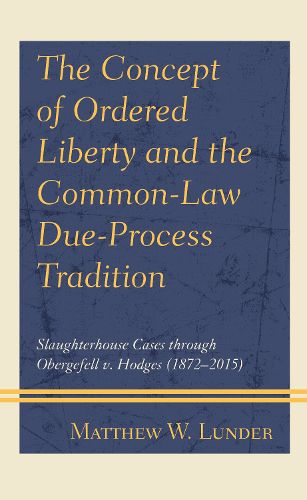Readings Newsletter
Become a Readings Member to make your shopping experience even easier.
Sign in or sign up for free!
You’re not far away from qualifying for FREE standard shipping within Australia
You’ve qualified for FREE standard shipping within Australia
The cart is loading…






The Concept of Ordered Liberty is a story of due process from the common-law tradition. Told through Supreme Court cases against a backdrop of political theory, legal philosophy and history, it illuminates a mid-twentieth-century dialectic between theories-liberal and conservative-for resolving controversies about state interference with personal liberties. So pervasive was the partisanship flowing from a riven body politic that every institution comprising the fabric of American society, including the federal courts, was soaked in it. But the ideological contest is not the story's primary concern. More pertinent to our dilemma today is what the clash of ideologies eclipsed: a venerable judicial practice deeply rooted in American history and tradition. The moral of the story is in this praxis at its center and its understanding of the limits of legislative and judicial power. The modern liberal and conservative approaches to fundamental rights fall short of the tradition, having strayed from the common-law concept of ordered liberty. Readers will find a suprapartisan perspective on the federal courts' obligation to resolve disputes about our Nation's most controversial issues, and a critical reflection on the modern Supreme Court's role in its politics.
$9.00 standard shipping within Australia
FREE standard shipping within Australia for orders over $100.00
Express & International shipping calculated at checkout
The Concept of Ordered Liberty is a story of due process from the common-law tradition. Told through Supreme Court cases against a backdrop of political theory, legal philosophy and history, it illuminates a mid-twentieth-century dialectic between theories-liberal and conservative-for resolving controversies about state interference with personal liberties. So pervasive was the partisanship flowing from a riven body politic that every institution comprising the fabric of American society, including the federal courts, was soaked in it. But the ideological contest is not the story's primary concern. More pertinent to our dilemma today is what the clash of ideologies eclipsed: a venerable judicial practice deeply rooted in American history and tradition. The moral of the story is in this praxis at its center and its understanding of the limits of legislative and judicial power. The modern liberal and conservative approaches to fundamental rights fall short of the tradition, having strayed from the common-law concept of ordered liberty. Readers will find a suprapartisan perspective on the federal courts' obligation to resolve disputes about our Nation's most controversial issues, and a critical reflection on the modern Supreme Court's role in its politics.